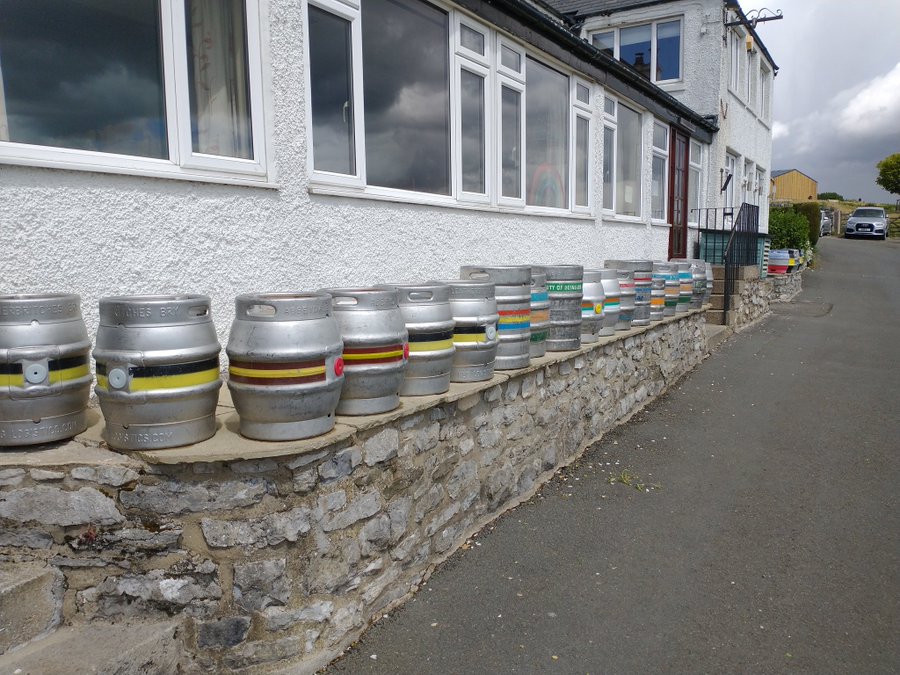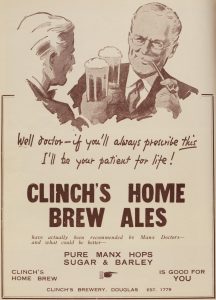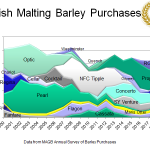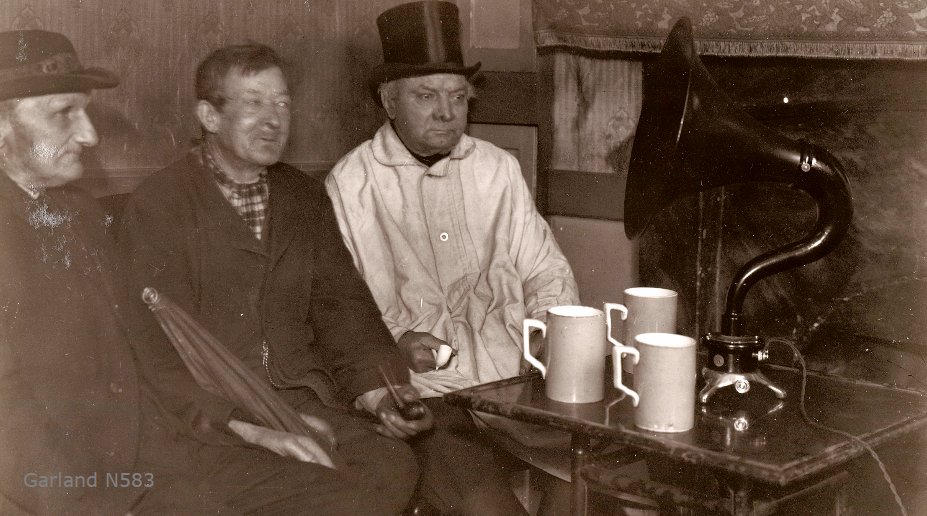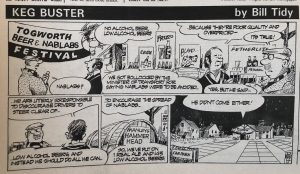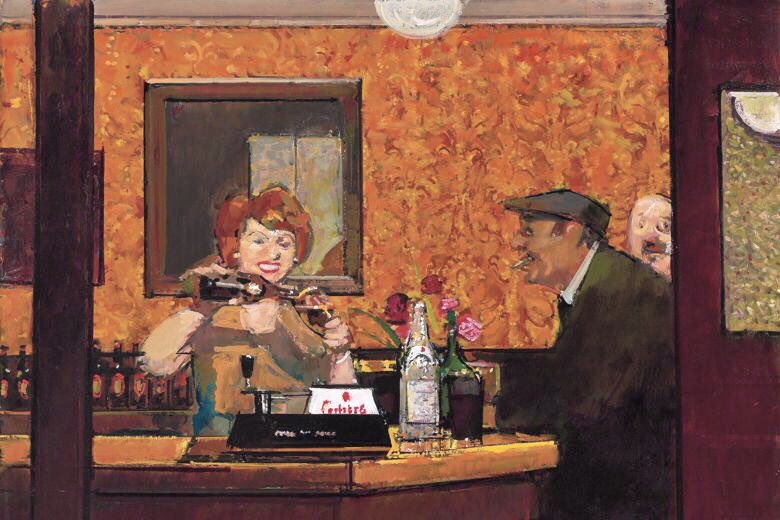I was thinking this week about an undergrad pal who used to say that February went by like a bat out of hell. Our small college of those days – just 400 students, half that in residence – has been making news for sad reasons this week so I have been thinking about those days a bit. But it is mid-February now and that means weeks from March and just as justice will have its day so shall the first coming warmth of spring. I am a bit all a giggle about it this year, frankly. I waaaay over invested in reusable row covers. Going to dig up have the lawn. Yup.
Sweetest bit of writing of the week has to go to Matt as he placed himself in the lineup at Pellicle and wrote about Dann Paquette and Martha Simpson-Holley of The Brewery of St. Mars. Many a love letter I sent to those two when they were on this side of the Atlantic brewing at Pretty Things. I send Matt my 2010 review of Jack D’or in response to Matt’s call for research materials. It provided him with background but I didn’t get quoted in the foreground. Oh… well… Anyway, the story is well worth your time:
Dann’s drawing of Jack D’Or, which depicts the “golden barleycorn”—as Martha’s poem describes him—bathing in a mash tun, adorns the label of a deliciously crisp, bold, yet balanced saison-style beer of the same name. It would eventually obtain something of a cult status among beer-loving Bostonites, New Englanders and others lucky enough to find it on tap, or get their hands on a bottle.
Oh. There I am. One of the lucky others. Thought for the day. A lovely summation of that which is the influencer:
She reminded me most of MPs I’d interviewed — the imperviousness to humiliation, the tolerance of rejection that let them go up to the public again and again.
Not unrelated.  Bad day in your early Renaissance? Someone was having one when this image was painted. H/T. Speaking of bad days, Ron has been posting interesting thoughts about why British beer became more boring in the 1980s and has been dipping into his own stream of consciousness as he does. This is his best sort of writing:
Bad day in your early Renaissance? Someone was having one when this image was painted. H/T. Speaking of bad days, Ron has been posting interesting thoughts about why British beer became more boring in the 1980s and has been dipping into his own stream of consciousness as he does. This is his best sort of writing:
I’m just back from a walk. Unless it’s pissing down, I always go for a walk around noon. A good time to think, while I’m strolling around my little patch of Amsterdam. Not just think, but start writing in my head. Phrases or even whole sentences. I can shuffle the words around before committing them to metaphorical paper. (That’s an example of a sentence I mentally wrote.) But let’s not stray from the point. I was pondering why and when UK beers became blander. A few things became clear. Oh, what I’m referring to is mostly cask-conditioned Bitter and occasionally cask Mild.
Writing. The waste of a good walk. Why is it so? And while we are at it, consider the lot of the freelancer, too.
Speaking of whom, Kate Bernot has popped up with an excellent article on the issue facing breweries in these times of supply chain problems – bottles or cans or back to bottles. It’s in a restricted medium uncomfortably self-identifying as Beer & (Craft) Brewing so I am constrained from telling you more. I think I had a free subscription offered last time I complained so it’s really all my fault. Who suffers? You do. Sad.
A book on Celis. Might have to get that.
Elsewhere in time, Casket Beer has provided us with some extra thoughts in great detail on the creation of another container, the Nonik glass and its genesis in the US soda fountain trade of a century ago:
Hugo Pick, of Albert Pick & Company, created the nonik, receiving its first patent in 1913 (some advertisements around the time also indicate a 1912 patent). Pick & Co. was a well-established service industry company based out of Chicago. They also owned and operated a chain of hotels. The Nonik Glassware Corporation was a licensee, and, according to the Crockery and Glass Journal, sole distributor of nonik glasses to the “jobbing trade”. They advertised widely, emphasizing a glass design that was 38-percent stronger than other glasses, and eliminated breakage and nicking by 40-percent, or 50-percent, depending on which ad you read.
Sticking with mid-20th century beer history, Gary G has examined the iconic Genesee Cream Ale of western New York:
To my mind Cream Ale has always been a quasi-American lager. Genesee Beer, according to the 1977 account, used as adjunct, “powder-fine and oil-free corn grits”, the proportion not specified. Genesee Beer only is mentioned in that section, not the Cream Ale, but I’d think the Cream Ale used the same adjunct. The rationale advanced for the corn is “starch to increase its ratio over proteins”, and this made the beer “lighter in colour, smoother in taste, and more pleasing to the palate”.
I mention this in particular due to the cream ale / cream beer connections that I wrote about a few years back. There is a thread here… but what?
Jordan has also posted in some detail, in his case the state of the Ontario beer market mid- to late-pandemic. There is a bit of futurism in there which will have to play out to see if it is correct. I am more of a “what is now is not the future” person myself but I am totally on board with the short term nature of the bottle shop hereabouts:
What we’re dealing with here is a loophole that looks to be open on a permanent basis, and as happens with loopholes, people are pushing the concept as far as it can go as quickly as they can push it. I’ll tell you the same thing I tell the people who get in touch: It would be a mistake to assume that these changes as they stand are permanent. They’re making it up as they go and it will likely continue towards liberalization. Opening a bottle shop at this point might be fun, but I’m not sure it’s going to work out long term.
Once the big money that has sat gathering at the sidelines moves back in, what is a state of flux will have settled and we will see where the real coins land. I am rooting for beer-mobiles – like bookmobiles meeting an ice cream van!
And Ren Navarro received an interesting honour of a bio in the Toronto Star this week. Nicely done.
Pete Brown reports that total UK beer sales are down +14% 2019 to 2020. One the one hand, bad. On the other, no too bad for the first pandemic in a century to his the nation. One solution for that might have been on the UK Tory government’s mind when they organized Brexit so so carefully – if one Brit retailer is correct:
Well looks like our importing of Belgian Beer is over. Software needed to “talk” to HMRC is not cost effective. Nearly £550 a year – Unless anyone knows of a different route #Brexit
Finally, in this week’s police blotter we highlight… or rather get into a bit of detail about a new matter which is moving towards the courts with a very local flavour. Iconic Canadian band The Tragically Hip have brought a lawsuit against one Toronto-based branch of the InBev / AmBev / ThingieBev conglomerate called Mill Street Brewing for poaching their intellectual property, as the CBC reports:
The Tragically Hip are suing a Toronto brewery for alleged trademark infringement in the promotion of its 100th Meridian lager. The legendary Canadian band has filed a suit in Federal Court against Mill Street Brewery, a subsidiary of Labatt, which is owned by Belgian multinational brewer AB InBev. The Tragically Hip allege in legal documents that Mill Street has tried to “pass off on the fame, goodwill and reputation” of the band. “Many of you are probably under the impression that we are associated with Mill Street’s 100th Meridian beer — we are not,” the band said in a Facebook post on Tuesday. At The Hundredth Meridian was a hit single on the Hip’s 1992 album Fully Completely. Its title refers to the line of longitude that marks the beginnings of the Great Plains.
The reaction has been swift and folk are eager to pounce. [Update: here is Josh Hayter of Spearhead on FB Thursday morning:
…they are using someone else’s intellectual property to sell their beer. They have been implying for years that the band supports their beer. If you think for one second if the positions were reversed, (someone using any AB product to promote anything they were doing) AB would not have an ARMY of lawyers up their backside in a second you are sadly mistaken…]
I have to admit a slight conflict as the band and its late singer originated here in my hometown and, while I never met one of the members, my late folks knew Gord Downie’s folks. Such is the town. That being said, I was personally and professionally quite surprised and even astonished that there had not been a licensing arrangement when the beer was created. Exactly no one in Canada knows that the “100th Meridian” is anything but a tune by the Hip. Crafty people even make crafts about the connection here in town. A huge hit. As the Winnipeg Free Press (the paper of record in that fair city) noted in 2011: “…the band slammed into the unforgettable riff to the 100th Meridian..”
“Unforgettable…” In his podcast, Ben mentions this week that there were failed negotiations before the lawsuit but that now Mill Street is in for a “world of hurt.” And he is right. This is dumb and was well known. And the marketplace confusion is clear. In 2014, the Calgary Herald (the paper of record in that fair city) wrote of the release of the then new beer and always unexciting beer:
To steal a line from Gord Downie and the Tragically Hip, 100th Meridian Organic Amber Lager from Mill St. Brewery is where the great plain begins. (That’s a bit harsh, but I couldn’t resist the joke.) Seriously, though: the concept here is laudable — make a beer with barley from Canada’s breadbasket, the Prairies — but it falls short in the execution…
In 2015, The Tomato food and drink blog stated in a column written by Peter Bailey:
…Call it a classic Canadian compromise, Alberta barley married with Ontario water, with a name that calls to mind a great Tragically Hip song (“At the hundredth meridian / Where the Great Plains begin.”)…
In 2016, Simcoe.com recommended including the beer in any Hip themed party:
“…offer up Mill Street Brewery’s 100th Meridian Amber Lager and some of the band’s own Fully Completely and Ahead By a Century wine from Stoney Ridge Estate…”
And in 2017, one beer blogger wrote: “I have no idea if the beer is paying honour to the band or not, but here in Canada it’s great marketing.” Yesterday, Jordan shared his recollection from the beer release party in 2014 that the brewmaster at the time claimed he had not heard of the song. Stunning – if only to indicate that they had their head in the sand and did not one bit of intellectual property investigation before the beer got named. Lesson: pay attention to reality, brewery owners. Make sure you are aware of what is going on in culture and the law.
That’s it. Watch your nose. Don’t step out of line. Pay your bills. And for more good reading check out the weekly updates from Boak and Bailey, back now mostly every Saturday, plus more at the OCBG Podcast on Tuesday and sometimes on a Friday posts at The Fizz as well. We have a new entry from the DaftAboutCraft podcast. And sign up for Katie’s weekly newsletter, The Gulp, too. Plus the venerable Full Pint podcast. And Fermentation Radio with Emma Inch. There’s the AfroBeerChick podcast as well! And also look at Brewsround and Cabin Fever. And Ben has his own podcast, Beer and Badword. And remember BeerEdge, too.



